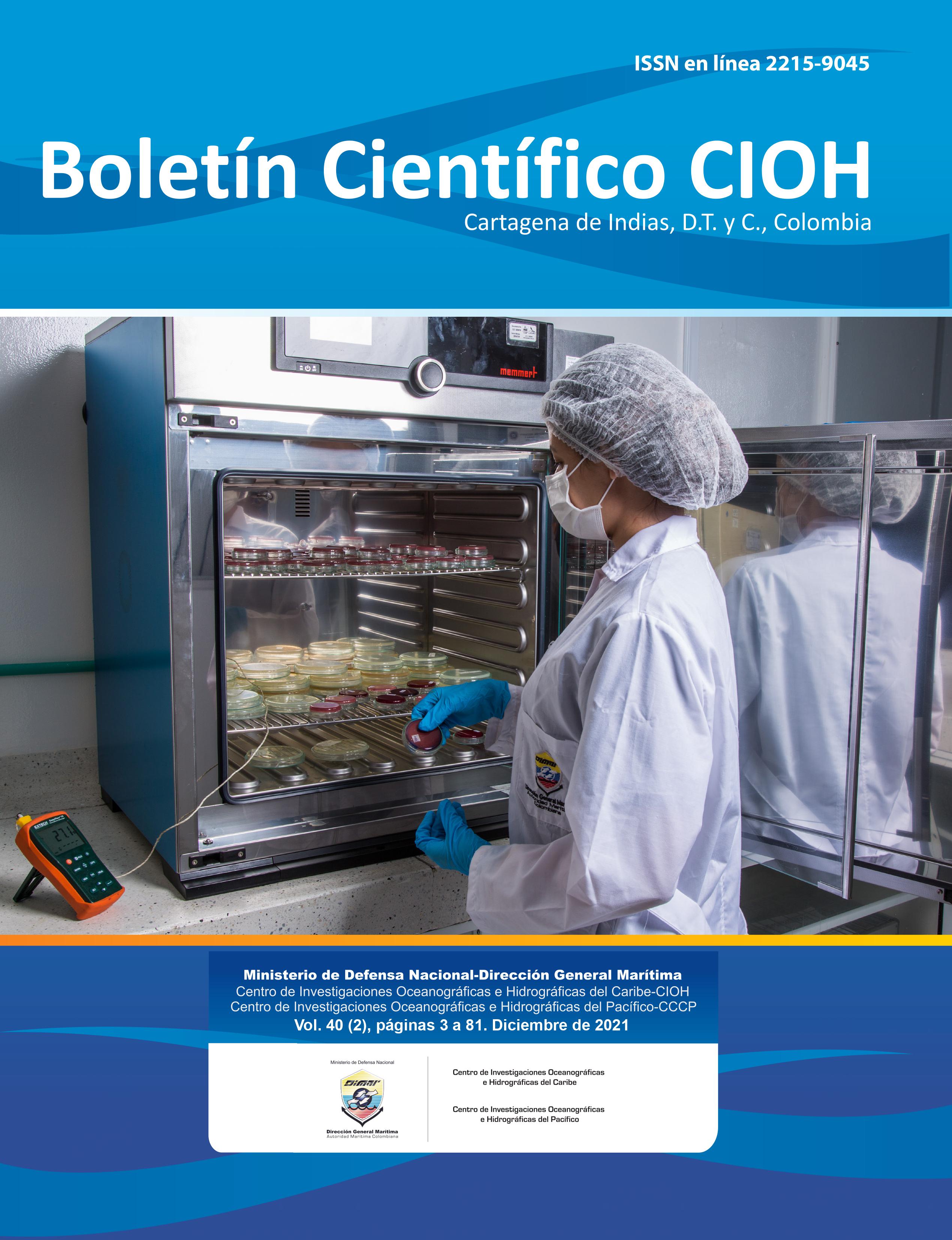Interpretation of the dynamics of the vegetation during the dry season in the Totumo swamp (Piojó, Atlántico), from the calculation of the normalized vegetation index (NDVI) and multi-temporal analysis, to Landsat 8 images from 2014 to 2020
DOI:
https://doi.org/10.26640/22159045.2021.556Keywords:
NDVI index, Totumo swamp, vegetation cover, meteorologyAbstract
The normalized vegetation index NDVI (Normalized Difference Vegetation Index) was calculated from Landsat 8 images (2014 to 2020) for the general environment (EG) and the area of direct influence (AID) of the Totumo swamp (Piojó, Atlántico) using the Geographic Information System (ArcGIS 10.5). The vegetation cover for the period analyzed, both in the EG and in the AID, describes periods where the higher vegetal classification categories (NDVI value > 0.2), present a higher percentage of cover and periods when the lower classification categories (≤ 0.2) presenting a higher percentage of vegetation cover. The largest vegetation cover during the study period was presented for the year 2020; however, this increase in vegetation cover category 2, which found inside the body of water, suggests an increase in the sedimentation of the swamp that has been colonized by some type of vegetation with photosynthetic activity.
Downloads
References
Villate Daza, D. A., Sánchez Moreno, H., Portz, L., Portantiolo Manzolli, R., Bolívar-Anillo, H. J., & Anfuso, G. (2020). Mangrove Forests Evolution and Threats in the Caribbean Sea of Colombia. Water.
Andrade Amaya, C., & Barton, E. (2013). Sobre la existencia de una celda de circulación atmosférica sobre el Caribe y su efecto en las corrientes de Ekman del Caribe suroccidental. Boletín Científico CIOH 31, 73–94.
Angeles , M., González , J., Ramírez‐Beltrán , N., Tepley , C., & Comarazamy, D. (2010). Origins of the Caribbean Rainfall Bimodal Behavior. JOURNAL OF GEOPHYSICAL RESEARCH, VOL. 115, 17.
Copernicus Climate Change Service . (21 de 10 de 2020). Copernicus Climate Change Service (C3S) confirms: July 2019 temperatures on par with warmest month on record. Obtenido de https://climate.copernicus.eu/copernicus-climate-change-service-c3s-confirms-july-2019-temperatures-par-warmest-month-record
Deutsche Gesellschaft für Internationale Zusammenarbeit (GIZ) GmbH. (2018). Protocolo para la generación de múltiples índices de vegetación a apartir de mosaicos satelitales del sensor LANDSAT.
Duval, V. S., Benedetti, G. M., & Campo, A. M. (2015). Relación clima-vegetación: adaptaciones de la comunidad del jarillal al clima semiárido, Parque Nacional Lihué Calel, provincia de La Pampa, Argentina. Investigaciones Geográficas, Boletín, núm. 88, Instituto de Geografía, UNAM, pp. 33-44.
Guzman, D., Ruiz, J. F., & Cadena, M. (2014). Regionalizacion de colombia segun la estacionalidad de la precipitacion media mensual, a traves analisis de componentes principales (ACP). Subdireccion de Meteorologia IDEAM.
Hurtado Montoya, A., & Mesa Sánchez, Ó. (2015). Cambio climatico y variabilidad espacio-temporal de la precipitación en Colombia. . Rev. EIA , 131–150.
INCODER-UJTL. (2011). Plan de manejo y ordenación pesquera del humedal Ciénaga del Totumo (Bolívar - Atlántico). Cartagena de Indias.
Instituto Colombiano de Desarrollo Rural y Universidad Jorge Tadeo Lozano. (2011). Plan de Manejo y Ordenación Pesquera del Humedal Ciénaga del Totumo. Cartagena de Indias, Colombia.
INVEMAR - CRA. (2007). Ordenamiento ambiental de la zona costera del departamento del Atlantico. Santa Marta.
INVEMAR. (2005). Actualizacion y Ajuste del Diagnóstico y Zonificación de los Manglares de la Zona Costera del Departamento del Atlantico, Caribe Colombiano . Santa Marta, Colombia, .
Loranty, M. ,., Davydov, S. P., Kropp, H., Alexander, H., Mack M, C., Natali, S, M., & Zimov, N, S. (2018). Vegetation Indices Do Not Capture Forest Cover Variation in Upland Siberian Larch Forests. Remote Sensing,10 (11).
Manrique, E. (1999). Indice de vegetacion. Aplicacion del NDVI. 217 - 219. España.
Meneses-Tovar, C. L. (2011). El índice normalizado diferencial de la vegetación como indicador de la degradacion del bosque. Unasylva 238, Vol. 62.
Ministero del Medio Ambiente. (2002). Politica Nacional para Humedales interores de Colombia. Estrategias para su conservacion y uso sostenible. Bogota D.C.
Montaner Salas, M. E., & Sanchez-Almohalla Serrano, E. (1988). Aproximacion por el metodo de Thornthwait, al cálculo de infiltración de lluvia útil. Papeles de Geografia No 14, 223 - 235.
Rueda Calier, F., Peñaranda Mallungo, L. A., Velásquez Vargas, W. L., & Díaz Báez, S. A. (2015). Aplicación de una metodología de análisis de datos obtenidos por percepción remota orientados a la estimación de la productividad de caña para panela al cuantificar el NDVI (índice de vegetación de diferencia normalizada). Corpoica, vol. 16, núm. 1.
Taufik , A., Sayed Ahmad, S. S., & Ahmad, A. (2017). Classification of Landsat 8 satellite data using NDVI thresholds. Journal of Telecommunication, Electronic and Computer Engineering, 37 - 40.
USGS . (18 de Septiembre de 2020). Landsat Missions. Obtenido de https://www.usgs.gov/core-science-systems/nli/landsat/landsat-8?qt-science_support_page_related_con=0#qt-science_support_page_related_con
Downloads
Published
Issue
Section
License
Copyright (c) 2021 CIOH Scientific Bulletin

This work is licensed under a Creative Commons Attribution-NonCommercial-NoDerivatives 4.0 International License.
Attribution — You must give appropriate credit, provide a link to the license, and indicate if changes were made. You may do so in any reasonable manner, but not in any way that suggests the licensor endorses you or your use.
NonCommercial — You may not use the material for commercial purposes.
NoDerivatives — If you remix, transform, or build upon the material, you may not distribute the modified material.
No additional restrictions — You may not apply legal terms or technological measures that legally restrict others from doing anything the license permits.



